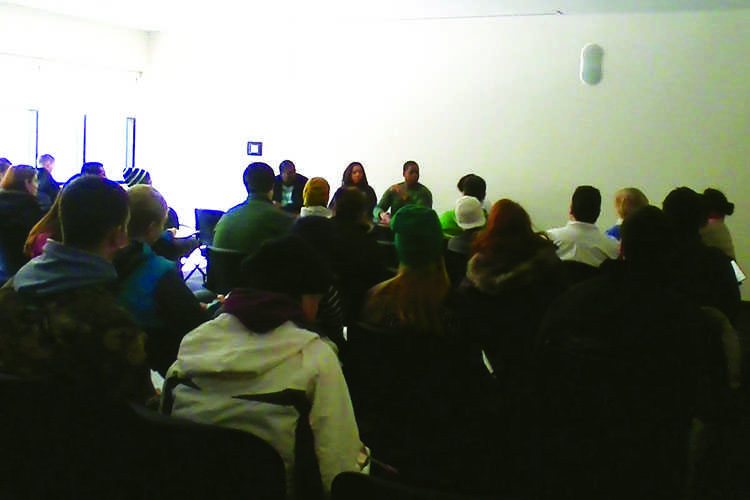Insight into interracial dating
Students share experiences and ideas at panel for African-American History Month
Photo by Rachel Streich
February 13, 2014
Among the array of ads on TV for the Super Bowl, a Cheerios commercial depicting a multicultural family appeared on the screen. Although images like these are now more prevalent in popular media, a group of students and faculty members said our society is still in the process of fully welcoming the idea of interracial couples.
On Monday afternoon in the Ho-Chunk room of Davies Center, a panel of students shared their experiences with interracial dating. The event, in conjunction with African-American History Month, has taken place for several years allowing people on campus to ask and answer questions about the topic. This year more than 40 students and professors attended.
The discussion points focused on interracial dating in American society as well as on campus.
Isiah Cage, a junior on the panel, related his experience of the “Eau Claire stare” in the past while walking around on campus with his girlfriend of a different race.
While some people may think encounters like this don’t happen in today’s world, they do occur and are worth discussing in this context, Aleshia Green, a senior on the panel said.
During the event she said places like St. Paul, Minn. and Chicago are more accepting of interracial couples because they are more diverse cities. It is more common to see interracial couples walking around the Mall of America than around UW-Eau Claire, she said. This could be because only eight percent of the student body is multicultural, according to the 2013-2014 UW-Eau Claire Factbook.
Gender can also play a part in perceptions of interracial dating. The panel shared views of how normal it is for white men to date black women and vice versa.
The panel addressed ways their families and friends have reacted to interracial dating as well. Some members of the panel said their families and friends have been fully accepting, while others said it might take time to see it as normal.
During the event, Green said people tend to have expectations of her to date a black man. However, she said the people she knows will adjust to the idea of her dating a white man.
But interracial couples are not just among black people and white people. Jones posed the question of whether or not white and black people dating rises to a different level than people of other races dating or marrying.
The Loving v. Virginia Supreme Court decision in 1969 said laws could no longer be made to keep people from dating outside racial groups. But the laws before this time only applied to black and white people.
Carlos Diaz, a freshman political science major, said because of America’s past, he thinks people are more prone to object to dating relationships between black people and white people.
As a whole, Diaz said the event shed light on an important subject and brought up relevant topics he identified with as a person from a multicultural family.
“It’s an interesting topic because you hear about this and you live it and you see it … I definitely grew from (the discussion),” he said.
Justina Kinard, a sophomore education major, said the panel was an opportunity for students to open their eyes to interracial dating and to think about how people can have meaningful relationships across racial lines.
The greater hope, Jones said in the discussion, is for people to consider integration in intimate relationships so society can be unified.

